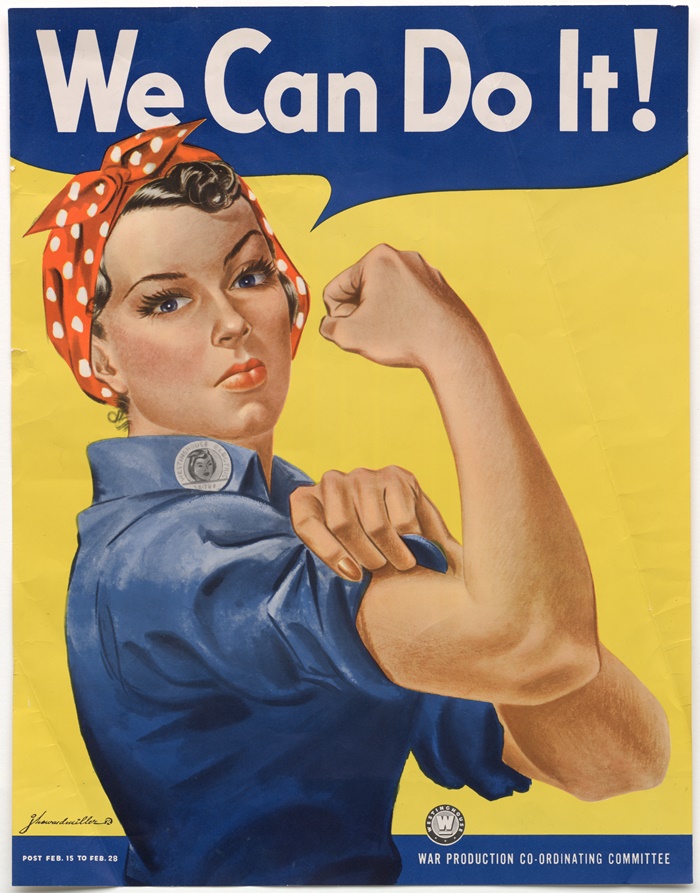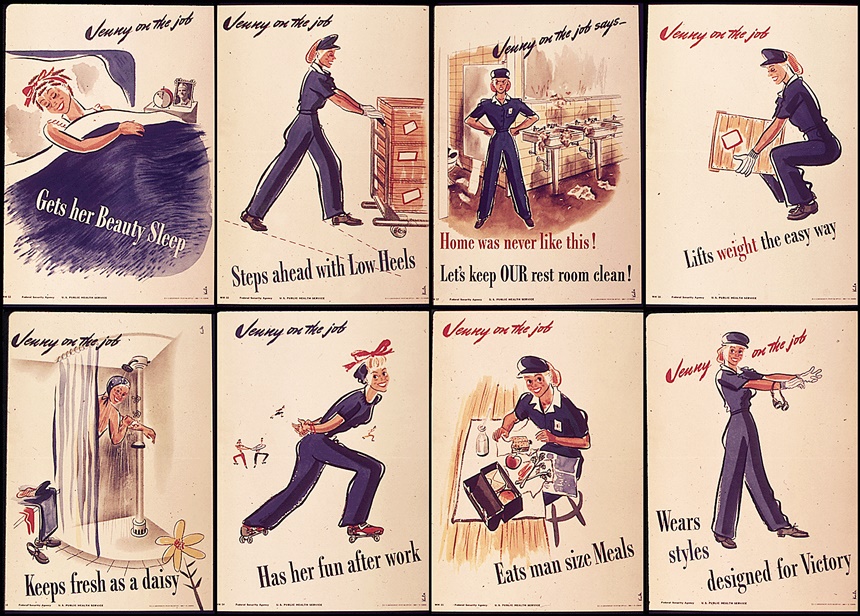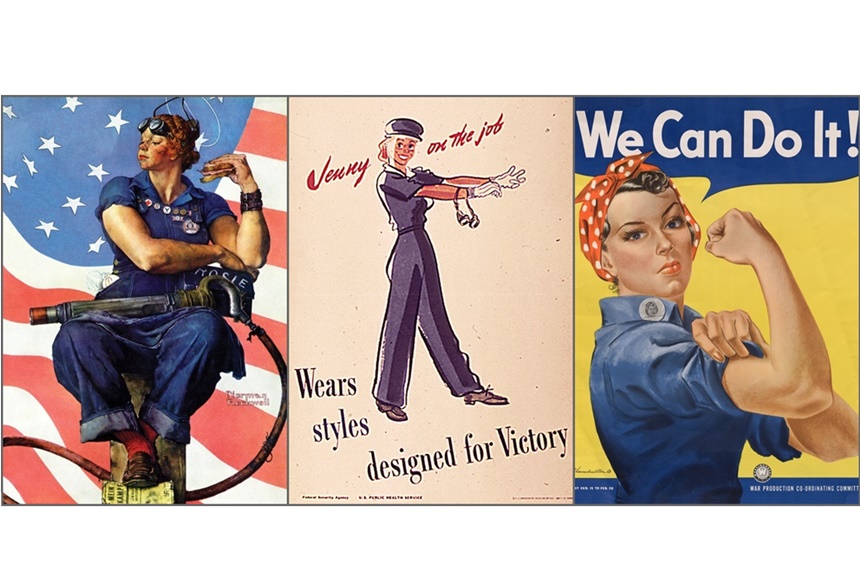By February 1943, Fortune magazine was reporting that more than four million American women had taken jobs to support the nation’s efforts toward winning World War II. Their work became immortalized the same month when a new song called “Rosie the Riveter” hit the airwaves. The lyrics, composed by Redd Evans and John Jacob Loeb, crafted a portrait of a young woman doing her part to help the United States win the war. Rosie, the song said, “Keeps a sharp lookout for sabotage” and argued “that little frail can do more than a male can do.”
“Rosie the Riveter” sung by The Four Vagabonds (Uploaded to YouTube by The Four Vagabonds – Topic)
It was a song full of catchy lines, but the artists who recorded “Rosie the Riveter” added something more of their own, too. The Four Vagabonds were a Black male singing quartet, originally from St. Louis, Missouri. When recording “Rosie the Riveter,” their voices mimicked the sounds of a rivet gun, the tool many women in aircraft factories used in their daily work.
Today, when Americans hear the name “Rosie the Riveter,” they immediately connect the name to an idea. The name has become synonymous with women’s work in World War II. But few Americans connect Rosie to the song that made women’s wartime work famous, or the first image of Rosie made for American audiences. On May 29, 1943, The Saturday Evening Post published Norman Rockwell’s painting of Rosie the Riveter on its cover. During the war, it would be one of his most recognizable works.

Rockwell’s Four Freedoms paintings, still familiar to many Americans decades later, and Rosie became part of a national tour during the war. His Rosie, along with the song, would have been in the front of Americans’ minds when they thought about working women during the war. Rockwell’s Rosie is a strong woman, her muscles clearly defined from long shifts in the factory. She appears to be on a lunch break from one of those shifts, a half-eaten sandwich in one hand. Rockwell’s Rosie balances her rivet gun in her lap, ready to return to the job at a moment’s notice. Symbolically, Rosie is stepping on a copy of Mein Kampf, indicating that she’s doing her part to take out Nazi Germany.
Rockwell photographed Mary Doyle Keefe to create his Rosie, although he took many liberties with his subject. Keefe was a telephone operator, not a factory worker, but this did not matter. As a working woman, she, too, was supporting her country in wartime. Inspired by the popular song and the millions of women heading to work each day, Rockwell transformed Keefe into Rosie.
But Rockwell’s Rosie is not the image most people think of when they hear the name “Rosie the Riveter” today. In the early 1980s, an obscure World War II workplace poster nabbed the spotlight and took the place Rockwell’s Rosie once had in popular imagination.

The Rosie that is most popular today sports a red and white polka-dot bandana, her shirt sleeves rolled up as she flexes her bicep. The banner overhead, “We Can Do It!,” is often interpreted as a slogan intended to empower women. This image, however, was not specifically Rosie the Riveter. Instead, the “We Can Do It!” poster was created to be hung briefly inside Westinghouse Electric factories. The image was part of a larger workplace campaign to encourage workers to be productive and to stay on the job. It was wartime, and posters like “We Can Do It!” emphasized workers’ roles in supporting the war cause. “We Can Do It!” was not designed to encourage women to join the workforce, but to encourage women who were already there to keep doing their part.
Rosie wasn’t the only image of working women in World War II, however. While Rockwell’s Rosie is no longer as famous as Westinghouse’s “We Can Do It!,” another wartime figure has been all but forgotten: Jenny on the Job.
As women moved into jobs they had never held before the war, additional propaganda campaigns focused on teaching women how to be good workers. At the same time that Rosie captured the national imagination in 1943, the Office of War Information’s Office for Emergency Management was developing a series of posters showcasing how Jenny did her job correctly.

The eight-image Jenny on the Job series emphasized the right things women should do on and off the job. Several posters instructed women on safe working habits, like lifting with their legs rather than their backs, and choosing clothing, shoes, and other safety tools suitable for their jobs. One poster suggested that young women in the workplace may not have understood how to take care of the facilities around them. “Home was never like this! Let’s keep OUR restrooms clean!” showcased the problems of leaving workplace bathrooms dirty.
According to the Jenny on the Job series, working women should get enough sleep, eat the right amount of food to take care of themselves, and even engage in fun activities outside of work. These simple messages offered working women reminders that it was important to do things that made them healthy and happy in addition to serving their country through the workforce. One poster, “Jenny on the Job Keeps fresh as a daisy,” encouraged women to shower regularly, focusing on the importance of personal cleanliness.
There’s no evidence that the “Fresh as a daisy” poster was a response to Rockwell’s Rosie and her dirt-smudged face in any way. While “Jenny on the Job” and “We Can Do It!” suggest that working women could remain clean, neat, and glamorous at all times, Rockwell’s Rosie was more than just a pretty face. His vision of Rosie reminded Americans that hard work could and would change the nation’s women.
Jenny on the Job never became as famous as Rosie, but both represent the same people. Jenny, the Rosie from the song, Rockwell’s Rosie, and Westinghouse’s working woman all highlight the important place American working women had in the country during World War II. Nearly eighty years after the war ended, Rosie, Jenny, and their sisters endure.
Become a Saturday Evening Post member and enjoy unlimited access. Subscribe now




Comments
Non traditional work roles were not new to all women. Like my paternal grandmother and aunt living on a farm meant work was assigned by sex but age or abilities. It wasn’t man’s or women’s work just work that had to be done by whoever stood too long in one place daydreaming.
‘ Rosie The Riveter’-The song highlighting the prowess of women , especially their role in the II world war effort of the US rivetted millions of listeners and there were many unsung women in the background , who also contributed to encourage sailors and army men at war and it is most welcome that The Saturday Evening Post has highlighted women like Rosie
“Rosie the Riveter” by the Vagabonds is new to me, even though from ’43. Fantastic tune, lyrics, harmony and the riveting sounds. Rosie and Jenny both had their places back then, and still do now. “We Can Do It” as well. We honor our military in all roles, and must keep them safe, so they can keep us all safe.
This means the government not intentionally antagonizing and provoking other nations into conflicts of killing for profit. It bears repeating World War II was the last war our country ever won, because it WAS justified. That’s it.